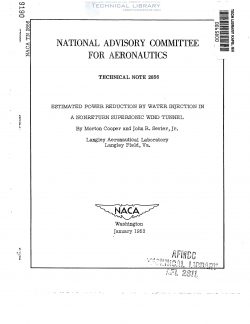naca-tn-2856
- Version
- 34 Downloads
- 610.94 KB File Size
- 1 File Count
- January 20, 2017 Create Date
- January 20, 2017 Last Updated
National Advisory Committee for Aeronautics, Technical Notes - Estimated Power Reduction by Water Injection in a Nonreturn Supersonic Wind Tunnel

A simplified analysis has been made to estimate the extent to
which the pressure ratio and power of a nonreturn supersonic wind tun-
nel operating in the low supersonic Mach number range can be reduced by
the evaporation of water injected into the diffuser. It appears to be
theoretically possible to reduce the power by as much as 20 percent for
a typical example of a tunnel operating at a Mach number of l.h and at
the following stagnation conditions: pressure, 15 pounds per square
inch; temperature, 2000 F; and dew point, 00 F or less. For a tunnel
having a test section of 50 square feet, the amount of water injected
would'be about 300 gallons per minute and the power saved, about 7,000
horsepower. The power required to provide the necessary water and the
possible increases in diffuser losses associated with water injection
must, of course, be weighed against the theoretical power saving.
The recent increased interest in experimental research at transonic
and supersonic speeds has resulted in the design and operation of large—
scale wind tunnels having operating powers in excess of 50,000 horse-
power. In some proposed designs considerably greater powers have been
contemplated. The use of methods for improving the operating efficien—
cies, even though the improvement may amount to but a few percent, would
therefore result in significant power savings. The purpose of this
paper is to determine the extent to which cooling by the evaporation of
water in the diffuser of a wind tunnel may theoretically improve the
operating efficiencies of the tunnel at transonic and supersonic speeds.
Such a method presupposes a nonreturn tunnel, a type which is currently
in favor for propulsion investigations.
Although the method in principle is not unlike the thermodynamic
drive discussed, for example, in reference 1, it differs considerably
in application. The thermodynamically operated wind tunnel employs
both heaters and coolers (water evaporation), which serve as a primary
drive and eliminate the usual compressor and electric motors, and thereby
constitutes a tunnel radically different from the type now in operation.
The present scheme is merely a device supplementary to the conventional
drive and utilizes the dry tunnel air which is otherwise wasted. No
basic tmnel-configuration changes are required other than those needed
to introduce the water.
| File | Action |
|---|---|
| naca-tn-2856 Estimated Power Reduction by Water Injection in a Nonreturn Supersonic Wind Tunnel.pdf | Download |

Comment On This Post